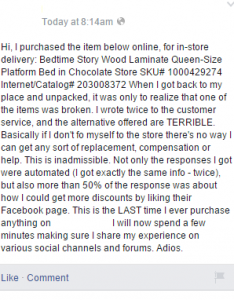
If you own or manage an e-commerce business, then you’re aware that a solid customer experience (CX) strategy is vital to success. But before you consider tackling CX, it’s important to understand what it is and what it can do for your business.
What does customer experience mean?
In the context of e-commerce business and online retail stores, customer experience refers to how a brand manages to engage its customers across the web.
Customer experience describes a customer’s perception of how a company interacts with them, and vice versa. Whether it’s in-store, through mobile, or web, this perception is the driving factor that affects customer behavior. It builds brand memories and encourages brand loyalty.
Think of CX as the “fingerprints” you leave on your customers. Every step of the journey— from the first impression to repeat purchases—is essential. Hence, businesses should evaluate every touchpoint of consumers who shop with you.
Pleasant experiences encourage better revenue, positive reviews, and lifelong customers. By contrast, a poor customer experience leads to the opposite.
Basically, if customers love interacting with you, they’ll recommend you to others and stay with you longer. In many cases, customer loyalty can actually last generations, or for the life of the brand, itself.
Takeaway: The best form of marketing money can buy in the e-commerce business is a customer who is willing to promote your business for free.
Why is customer experience a buzzword in e-commerce?
These recent stats and predictions shed some light on the question.
- 86% of consumers are willing to pay more for improved customer experience.
- 49% of shoppers made impulse buys after personalized experiences.
- 40% of data analytics projects will relate to customer experience by 2020.
When it comes to providing a superior customer experience, “people” and “product” are the main drivers. Obviously, your visitors should be impressed by how your product performs. But customers should also be delighted by your customer support agents, should they seek their help.
What are some ways to improve customer experience?
Managing user identity can ensure a smooth and scalable response to the growing demands in customer expectations. To prepare your enterprise business for success during the holiday season, here are five opportunities to consider without breaking the bank.
1. Deliver enhanced mobile experiences to exceed rising consumer expectations.
Providing an excellent mobile e-commerce (m-commerce) shopping experience can benefit retailers significantly. By 2021, m-commerce sales are expected to be responsible for 54% of overall e-commerce revenue, predicts Big Commerce.

This is one of the reasons why your online retail store should be easily accessible on mobile devices, not just desktops and laptops.
Keep in mind that your mobile sites should be optimized. In fact, Think With Google reports that 53% of customers will abandon your site if it takes over three seconds to load. When they do bounce, chances are they’ll go straight to your competitors. One way to optimize your site is to reduce the file size on your website’s images.
“If a (Google) bot finds that your site is hostile to mobile users or loads very slowly, you’re going to lose rank.
– John Lincoln, CEO of Ignite Visibility
If more than 30% of your site visitors arrive via their smartphones, create a dedicated mobile app. These are far more efficient than responsive designs and offer a better customer experience.
Once your mobile app is in place, you’ll need a digital transformation strategy to enhance and update processes and technical capabilities that will meet your customers’ demands.
A solution to this is using a digital identity platform. This is a reliable way to engage customers during the holiday season and beyond, while enriching their digital experience.
2. Your mobile strategy should satisfy customers at ALL touchpoints.
Brick and mortar retail isn’t dying. Many business owners have revived it with a digital strategy that personalizes their customers’ experiences.
Since shoppers combine digital and mobile shopping with in-person buying experiences, retailers should include mobile-friendly touchpoints in their marketing strategies.
Here are strategies for improving customer experience in store, and out:
- Trigger relevant chat, email, or SMS workflows when users engage with mobile devices.
- Include on-the-spot buyer guides, product fact sheets, and upselling suggestions on your sites and apps.
- Use aggregate e-commerce data from customer identities to build marketing schemes.
- Install in-store kiosks with complementary products, allowing users to compare items.
- Synchronize profile and buying information between devices and physical locations by using customer identity and access management (CIAM) software
In short, integrating digital and traditional touchpoints using CIAM tools will help you build customer satisfaction and loyalty that lasts.
“Expect to see more shoppers using mobile, especially as brands begin to encourage more in-store mobile engagement through push notifications and SMS messaging.”
– Rick Kenney, Head of Consumer Insights, Salesforce

3. Emphasize the employee experience to boost customer retention.
The best way to leverage the correlation between employee and customer experience is to create an employee experience portal. This portal can be an intranet system that will send customized messages to your employees and further boost their engagement with your customers.
Kick this strategy off by deploying surveys to employees. This way, you can gain insights into consumer expectations, plus introduce engagement programs and other incentives.
4. Use personalization techniques and loyalty programs to get ahead in e-commerce.
One good example of the new generation sales opportunities is the changing face of loyalty programs. About 70% of shoppers prefer loyalty programs and gift cards during their holiday shopping, and half of those customers will spend more on purchases than they otherwise would have.
One right way to achieve an optimized customer experience is by creating an experiential approach. Here are some tips on that.
Do not simply target customers with product suggestions in their loyalty program based on browsing history. Over one-third of users find this approach invasive. Instead, create a more experiential approach that incorporates predictive selling from user data; this encourages loyalty redemptions and upsells.
You can also add-in a unique, branded currency to appeal to your shoppers, further augmenting user-targets based on shopping activities.
5. Promote transparency often to foster good customer relationships.
With legislation like GDPR and CCPA, there will be few allowances for mistakes in 2020. E-commerce brands that accidentally make mistakes will have to own up to it and take immediate actions to avoid the backlash.
With large scale data breaches happening around the world, safety and transparency are being valued more than ever.
The best e-commerce digital experience platform should be GDPR compliant or at least provide the tools to make your brand GDPR-ready.
Southwest Airlines prides itself on being the largest low-cost carrier in the world, and it lists transparency as an important driver for its popularity. Their marketing campaign, “Transfarency” garnered over 5 million likes on Facebook and earned customer trust for promoting “no hidden fees or extra charges” as their value proposition.
But what about the privacy aspect of it?
No matter what e-commerce shopping experience you offer your customers, data security should be one of your biggest concerns. Cybercriminals are always on the lookout for loopholes to steal your customer’s private data.
What’s worse is that most customers often don’t take the necessary steps to protect themselves. CreditDonkey reports that 68% of customers use the same password for multiple websites. That’s a good reason for you to be extra vigilant when building a secure e-commerce customer experience. Here’s how you can get started.

Tips to protect e-commerce customer data
- Collect and store only important customer data that you need.
- Do not store credit card numbers and customer names for quicker checkout process.
- Demand strong, complex passwords that cannot be hacked or broken easily.
- Optimize your organizational control to prevent leaks and insider attacks.
- Set up website security with two-factor authentication and SSL certificates.
- Educate customers and encourage them to identify suspicious behavior.
- Introduce a web application firewall with built-in DDoS protection.
- Keep a backup solution in place to automatically back up files in the event of a breach.
- Conduct security awareness training for your employees, so they know how to spot suspicious activities.
- Develop a cybersecurity plan that clearly outlines what to do right after an attack.
- Stay up-to-date with security patches to prevent hackers from exploiting your data.
- Encrypt all passwords and sensitive customer data, so they are never compromised.
Conclusion
When it comes to growing your business, a smart e-commerce customer experience strategy is as important as a marketing strategy. With a customer identity and access management solution, you can get 360-degree customer profiling, with 100% customer consent, across all touchpoints. This allows you to personalize marketing and loyalty programs that engage your audience. And that’s a win-win for you and your customers.
Digital & Social Articles on Business 2 Community
(69)
Report Post






